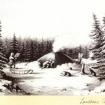Tshuu tr’adaojìich’uu OR Tshuu tr’idaodìich’uu
This canyon is one of the most significant places along the Peel River and there are many stories attached to it because of its danger and beauty. It is one of two canyons along the Peel River – the lower of the two – and the only one that is passable by boat. Its passage, however, requires a skilled boatsman. One who knows how to read the water, can avoid eddies and is comfortable with fast flowing water. The trip through the canyon today is a memorable trip. People consider it treacherous and treat it with great caution and respect.




